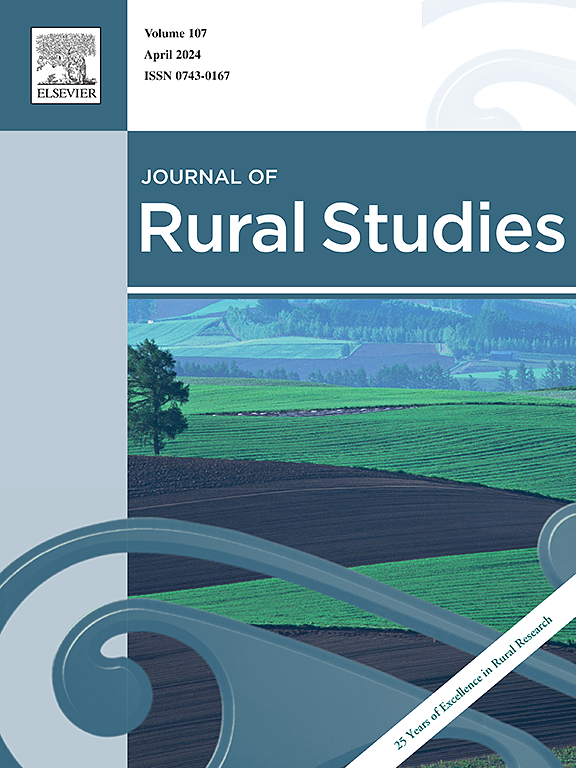解码农村地域异质性:基于极点-场-区网结构分析的优化路径
IF 5.7
1区 社会学
Q1 GEOGRAPHY
引用次数: 0
摘要
城乡发展不平衡是21世纪全球可持续发展的核心挑战,其实质是资源要素空间配置的结构性矛盾,有效识别农村国土系统的空间结构和发展类型是未来推动城乡一体化发展的重要途径。采用熵- topsis法、重力模型、K-means聚类、地理探测器等技术对滨县“极-场-区网”多维空间结构进行识别和构建。研究结果表明:(1)基于乡村地域系统“极-场-区-网”的多维结构框架,确定并划分了滨县6个乡村振兴极(VRP)、4个乡镇空间场(TSF)和10个乡村发展区(VDA)。其中,VRP通过经济辐射效应带动周边地区发展,TSF作为城乡要素流动的载体促进资源交换,VDA通过功能互补形成协同效应。(2)农村和村级综合地理资源开发指标客观反映了东北典型农业县农村空间发展的差异性,其发展水平均表现出明显的地理分异。(3)构建了农村国土系统发展类型的识别方法,探索了不同乡镇区域联系分布特征的差异。基于功能优势和发展定位的差异,对不同类型的乡村振兴极、村镇空间场和乡村开发区提出了有针对性的优化路径。该研究为全球城郊一体化村提供了案例研究,对于破解城乡二元对立、建立双向要素流动渠道、促进城乡功能空间重构具有深远意义。本文章由计算机程序翻译,如有差异,请以英文原文为准。
Decoding rural territorial heterogeneity: Optimization pathways via Pole-Field-Area-Net structure analysis
The imbalance between urban and rural development is the core challenge of global sustainable development in the 21st century, and its essence is the structural contradiction in the spatial allocation of resource elements and the effective identification of the spatial structure and development type of rural territorial system is a critical way to promote the integrated development of urban and rural areas in the future. It employs the entropy-TOPSIS method, gravity model, K-means clustering, geodetector, and other techniques to identify and construct the multidimensional spatial structure of ‘Pole-Field-Area-Net’ in Binxian County. The results of the study demonstrate that: (1) Based on the multidimensional structural framework of ‘Pole-Field-Area-Net’ in a rural territorial system, six village revitalization poles (VRP), four township space fields (TSF), and ten village development areas (VDA) were identified and divided in Binxian. Among them, the VRP drive the development of the surrounding area through the economic radiation effect, the TSF promote the exchange of resources as the carriers of urban and rural factor flow, and the VDA forms synergistic effects through the complementary functions. (2) The integrated rural and village-level geographical resource development indicators objectively reflect the differentiated spatial development of rural villages in typical agricultural counties in Northeast China, with their development levels all showing apparent geographical differentiation. (3) A methodology for identifying the development types of rural territorial systems has been constructed, and differences in the distribution characteristics of regional links between different villages and towns have been explored. Based on the differences in functional advantages and development orientation, targeted optimization paths are proposed for different types of rural revitalization poles, village and township spatial fields and rural development zones. The study provides case studies for global suburban integration villages and has far-reaching significance in cracking the urban-rural dichotomy, establishing two-way factor flow channels, and promoting urban-rural functional spatial restructuring.
求助全文
通过发布文献求助,成功后即可免费获取论文全文。
去求助
来源期刊

Journal of Rural Studies
Multiple-
CiteScore
9.80
自引率
9.80%
发文量
286
期刊介绍:
The Journal of Rural Studies publishes research articles relating to such rural issues as society, demography, housing, employment, transport, services, land-use, recreation, agriculture and conservation. The focus is on those areas encompassing extensive land-use, with small-scale and diffuse settlement patterns and communities linked into the surrounding landscape and milieux. Particular emphasis will be given to aspects of planning policy and management. The journal is international and interdisciplinary in scope and content.
 求助内容:
求助内容: 应助结果提醒方式:
应助结果提醒方式:


